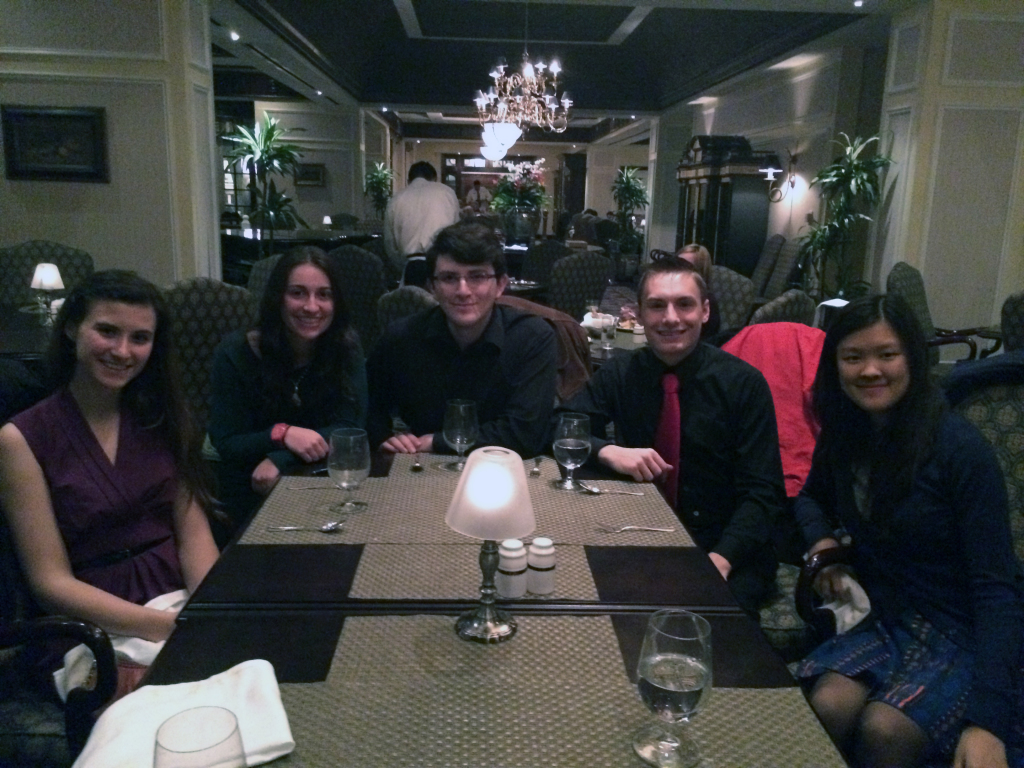This page is about my methods and goals with regard to teaching. For data and comments, go here. For syllabi, go here. For class websites, go here. Learn more about me as a person, my research, or my CV elsewhere.

Several years after their intro to philosophy class, many of my students from my Fall 2012 class took me out to a fancy dinner.
- Help my students develop clear and effective reasoning abilities
- Convey the material comprehensibly to facilitate long-term understanding
- Create an open, intellectual community in my classes that promotes friendly, constructive exchanges
Each of my classes is a workshop in reasoning. I often tell my students that the only test I care about is their ‘Five Year Test,’ by which point they will know if they have incorporated the lessons and virtues of philosophy into their lives. It is more important to me to teach my students to charitably interpret positions, analyze and evaluate arguments, and write college-level papers, than that they remember two dozen species concepts, for example.
This approach motivates each class period, as well. Rather than treating my lectures as narratives, I distill my teaching to a handful of central points I must cover in class that day. As I reach each new point, I repeat the previous points and show the chain of reasoning that connects the current discussion. At the beginning and end of each class, I summarize the content from the previous lessons, illustrating the connections between each lesson and the next.
If I have covered my chosen points for the day and the conversation veers to another topic, I have no qualms about exploring the philosophical issues inherent in the new topic. Students are more engaged when the topics are furthered by their own questions and answers, which I moderate to rephrase each student’s comments in the best, most fruitful light. I use that to foreshadow issues later on in the semester, preview other classes, or merely relate our discussions to those topics. As you’ll note, my students often remark on this in my evaluations.
In the first week of class, I make it a point for everyone in the classroom to learn everybody’s name (it takes about two weeks in my 40+ student classes) to foster a community of mutual respect in my classroom. Class discussions require mutual respect, so I hold one of my office hours in the local student union. I found that while students rarely came to office hours, they would come fairly regularly if they knew I’d be among them every week. This gives me extra time outside of class to keep students engaged, interested, and informed. During these hours, students have asked me to be their senior thesis adviser, for help with existential problems, for letters of recommendation, and for advice in their academic and career goals.
I try to make abstract concepts realistic by using biological, historical, or psychological examples. I find many students remain skeptical of philosophical views until they can be shown tangible consequences. For example, with explanatory reductionism, I usually refer to the history of successful reduction in biology and chemistry; for mereology, I explain the difficulty in individuating symbiotic relationships in biology; and for free will, I use the fascinating new cases in neuroethics and behavioral economics that challenge our traditional conception of will and action. By showing practical, realistic examples and consistently stressing the importance of getting clear on the response, I can make philosophy seem more present and relevant in students’ lives.
In short, I constantly strive to make philosophy relevant, interesting, and accessible for students in the long term. I am committed to reassessing my courses each time I teach them. To me, teaching is a lifestyle commitment.